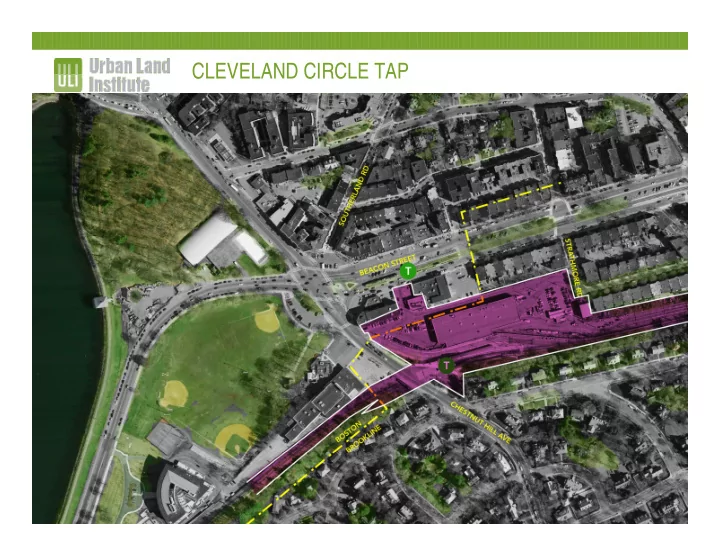

CLEVELAND CIRCLE TAP
ULI – the Urban Land Institute Mission To provide leadership in the responsible use of land and in creating and sustaining thriving communities worldwide. ULI is a non-advocacy research and education institution with over 35,000 members worldwide representing the entire spectrum of land use and real estate development disciplines, working in private enterprise and public service.
Technical Assistance Panels (TAPs) The MBTA requested that ULI Boston conduct a TAP to examine the development potential of its Reservoir Station and adjacent maintenance facility. Panelists have donated their time over 2 days – October 16 th and 28 th 2009 – to examine a full range of options from an outside perspective in order to provide unbiased feedback to the MBTA, as well as to Brookline and Boston. ULI Boston is committed to supporting the communities of New England in making sound land use decisions and creating better places. A Technical Assistance Panel (TAP) brings together of a group of ULI members with a range of professional expertise to provide focused, collaborative consultation to a local government or qualifying non-profit organization. This TAP • Sponsored by the MBTA • This panel looked at the full range of options from an unbiased perspective. • Panelists include experts in the fields of architecture, development, construction, transportation planning, law, landscape architecture • Final Deliverable – Written report (within 6 weeks) will be available at http://boston.uli.org
Introduction of Site The study area consists of four acres located in both Boston and Brookline including: 1. An active Green Line rail yard and maintenance facility 2. The “C” Green Line terminus station 3. Reservoir Station on the “D” Green Line and associated bus stop/drop off area 4. Cleveland Circle intersection and nearby parcels
Stakeholder Input Panel interviewed stakeholders on October 16 th , 2009. � Public Authorities: MBTA, Brookline, Boston � Residential Abutters � Commercial Abutters Common Themes Identified � T is an asset, however negative externalities associated with current use of site o Visual character; noise; traffic disruption � Future Uses should serve community without adding substantial impacts o Preference for mixed-use with amenities for local community o Potential for small retail, hotel, and/or home-ownership components; o Larger commercial uses should be avoided due to traffic draw; o Height should be consistent with neighborhood � Public Realm should be more pedestrian-friendly and foster community identity � Respect the historic character of neighborhood and circle, � Existing pass-through traffic volumes are heavy; development should be traffic neutral � Municipal boundary creates challenges; process of change is a slow
Site and Context Analysis Existing T Operations
Site and Context Analysis Historic Context
Site and Context Analysis Traffic •Current High Volume of traffic in all directions both am and pm peak hours - “F” Intersection •Intersection lane designations not clearly signaled striped or defined •Left turns from west bound Beacon to south bound Chestnut Hill difficult •On-street parking is highly utilized; often drivers park illegally rather than use available open spaces which delays traffic •Transit use is high by area residents •Pedestrian activity within the intersection is significant •Long queues of traffic come on all approaches during peak hours •Bicycle accommodations lacking
Site and Context Analysis Demographics – a Tale of two Cities… Boston •Significant component of population consists of undergraduate and graduate students from Boston College and other schools (mostly rental housing) •BC has committed to house 90% of student population on campus, however area will likely remain a draw for younger residents and students from other schools. Brookline •Composed primarily of single-family owned residences.
Site and Context Analysis Construction Cost Premium for elevated deck Deck Cost Drivers: •Productivity loss – cannot shut the facility down •Limited hours of construction •Building around the rail operation (overhead lines, tracks, etc) •Limited access to the work •Daily moving of equipment in and out of work zone •Rail personnel required to insure safety during construction •Complexity of structure and transfer conditions (loads do not stack) •Foundation locations limited by available “open ground” – efficiency decreased •Life safety & exhaust systems below deck – “tunnel” created Anticipated cost of platform = $400 per square foot
Design Guidelines and Goals Maximize Transit Oriented Development (TOD) opportunity – Concentrate density of mixed-use development around transit nodes Enhance Land Values Improve legibility of historic rotary at Cleveland Circle Pedestrian Improvements Improve Traffic Conditions Transit Station Upgrades – C and D line Connectivity of T Lines – Intermodal connections Protect and Enhance Historic Context Consistent Massing at Street Edge (Maximum 5-6 stories) with setbacks for additional height Enhance Public Realm, Mix of Uses with Neighborhood Amenities and Unique Sense of Place
T Site Redevelopment No Build Option • No Change to T Operations at Site – Maintain all existing operations
Similar T Initiative: Ashmont Station
Vision Public Realm Improvements Re-establish Cleveland Circle Identity Definition of Vehicular and Pedestrian circulation
T Site Development Concept
Conclusions Conclusions To unlock the full potential of the redevelopment of the T site, we need to look at the broader context of Cleveland Circle. There needs to be a mechanism to deal with multijurisdictional approvals and multiple parcels in separate ownership. We believe that past studies of Cleveland Circle have not been implemented because their focus has been too narrow and did not look at bigger picture.
Recommendations Recommendations Convene jointly-sponsored master planning process with Boston, MBTA/Mass DOT, and Brookline that would address planning and permitting, governance and cost/ revenue sharing. Conduct detailed feasibility analysis of how the current operations at the T site can be modified to maximize redevelopment opportunities without sacrificing functionality. Study the implications for land values and operational efficiencies and other benefits to the transit systems that would result from modification of the existing transit infrastructure. Convene a task force with members from both Boston, Brookline and MBTA/Mass DOT, possibly headed by neutral third-party
Recommend
More recommend